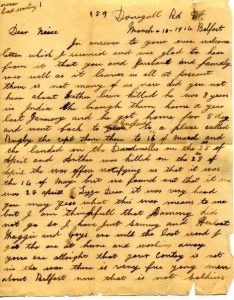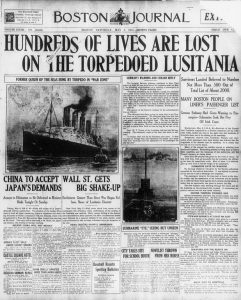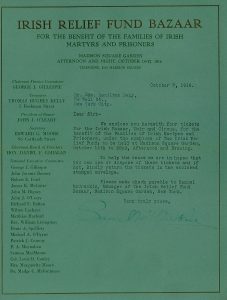On 6 April 1917 the United States of America declared war on Imperial Germany. Up until this point the United States had maintained the government policy of neutrality. However, neutrality did not keep the war from pervading American lives. As we can see from the letters sent and received during this time neutral America was still entangled in the far reaching grasp of a ‘European’ war.

Despite emigrating to the United States, newly christened Irish-Americans had a personal connection to the War as friends and family at home faced life on the front.Although conscription was not enforced in Ireland approximately 200,000 Irishmen enlisted and served in the British Army between 1914 and 1918[1]. The consequences of war were made clear to Elizabeth Dunlap when she received sad news from her aunt and uncle back in Belfast. Born in Ireland, Elizabeth married Robert Fadzen and settled in Pittsburgh, Pennsylvania. In March 1916 she received the unfortunate news that her cousin, Arthur Greer, had been killed in action during the Gallipoli campaign. While mourning for her son her aunt expresses relief that her other two sons, Herbert and Sammie, are safe.[2] Similarly, Margaret Loughren, formerly of Co. Roscommon was settled in Massachusetts when she wrote the Chief Secretary of Ireland, Augustine Birrell, begging him to send her sixteen year old brother, John Loughren, home after he enlisted in the British Army. Three years prior to his enlistment John asked to move to America to be with Margaret but she refused.[3] Denis O’Driscoll’s daughters Elizabeth and Susanna had also emigrated to Massachusetts. After settling in Boston their father writes to update them on the welfare of their brothers who are serving with the British Army.[4] For these recently christened Irish-Americans the War has a personal connection, while America has not yet become officially involved their families are already in action.

One of the greatest impacts of the War upon neutral America came through naval warfare along the Irish coastline. The sinking of the passenger liner, the Lusitania, is one of the first examples of American casualties upon the seas. Sailing off the coast of Co. Cork the Lusitania on 7 May 1915 the British Cunard liner was hit and sunk by a German torpedo. It took with it 785 passengers (including noted art collector Hugh Lane) and 413 members of the crew, among them 128 Americans.[5] The Lusitania would not bring the last American casualties before 1917. Following the return to unrestricted naval warfare German U-boats also sank the Atlantic liner S.S. California and R.M.S. Laconia in February alone. Just three days after President Wilson’s speech, breaking diplomatic ties with Germany, the S.S. California was torpedoed without warning off the coast of Co. Cork. Thirty-eight people drowned for a total of forty-three casualties.[6] Shortly after this event the R.M.S. Laconia was struck by German torpedoes causing it to sink off the coast of Cork. The sinking of the Laconia was taken as another form of German aggression as submarines appeared to target liners with no regard to the flying American flag. The following day President Wilson appealed to Congress declaring an urgent need for action against German aggression. One of his main requests was an ability “to employ any other instrumentalities or methods that may be necessary and adequate to protect our ships and our people in the legitimate and general pursuits on the sea”.[7] It had been pressure from neutral America which kept unrestricted warfare to a minimum in 1915 and 1916, however, by early 1917 this had all changed.

Finally, before the end of neutrality, nationalist Irish-American political groups in the United States were enjoying a level of support previously unknown to them. Historically, Irish nationalists had often sought the aid and support of their cousins in the United States. Leading up to the War the United Irish League (UIL) had provided valuable financial backing to Redmond’s Irish Political Party, heightened in 1914 by the prospect of Home Rule.[8] Although Redmond’s backing of the British war effort cost him his American support base, the Friends of Irish Freedom (FOIF) filled the political vacuum. The organisation was formed a few weeks prior to the Easter Rising in order to promote the cause of Ireland in the United States.[9] While the American government advocated a solution to the Irish question, sympathy for the campaign grew larger in reaction to the executions of the leaders of the 1916 Rising.[10] In response to the damage caused by the Rising a relief campaign was set up in America to raise funds for those affected. Hosted in Madison Square Garden the Irish Relief Fund Bazaar aimed to raise money for the families of ‘Irish martyrs and prisoners’.[11] “The Charitable People of America” were asked to support the Irish cause recover from the “terrible scourge of war, which has devastated so many countries in Europe.”[12] While anti-British sentiment was at a high in the States resident Irish political groups, such as FOIF and Clan na Gael, were not utilizing this sentiment as a means to encourage war but rather to maintain the American stance of neutrality. The aim was to maintain neutrality and to remove America from the grasp of British influence.[13] This campaign was ultimately unsuccessful as America declared with the Allies in April 1917. Although the decision to declare war went against one of their principal aims FOIF reluctantly began to conform to the wartime spirit. In response to government fears that the European conflict would produce conflict in their own nation between immigrant groups, the American government directed ‘Americanisation drives’ at foreign-born Americans who strongly identified with their country of their birth.[14] Such people became known as ‘hyphen-Americans’ and attacks on America’s new ally became ‘un-American’. On the eve of American entry into the war the Clan issued a circular conveying their support, ‘We will remain loyal and will yield to none in the devotion to the flag, whether the United States goes to war or remains at peace’.[15]
In conclusion, while America was officially neutral until 6 April 1917 the war reached many corners of the United States. Both connecting on a personal and political front the climate of war, neutral or not, resulted in American loss of life, loss of family and creation of political organisations. The rise of FOIF and its eventual move into the war movement highlighted a shift in Irish-American nationalist politics which saw “American” dominating the hyphen battle.
References:
[1] David Fitzpatrick, ‘Militarism in Ireland, 1900–1922’ in Tom Bartlett & Keith Jeffreys (eds), A Military History of Ireland (Cambridge, 1996), p. 397.
[2] Letter from Greer to Elizabeth Dunlop Simpson Fadzen, 13 March 1916. https://letters1916.ie/diyhistory/items/show/1914.
[3]Letter from Margaret May Loughren to Augustine Birrell, 26 March 1916. https://letters1916.ie/explore/letters/1350.
[4]Letter from Denis O’Driscoll to his daughter Bessie, 12 July 1916. https://letters1916.ie/explore/letters/428.
[5]Frank Trommler, “The Lusitania Effect: America’s Mobilization against Germany in World War I.” German Studies Review 32, no. 2 (2009): p. 241. http://www.jstor.org/stable/40574799.
[6]Unknown, ‘German sub sinks U.S. passenger ship California’, History.com (2009) (http://www.history.com/this-day-in-history/german-sub-sinks-u-s-passenger-ship-california). Date accessed: 28 January 2017.
[7]“THE WEEK IN REVIEW.” The Journal of Education 85, no. 10 (2120) (1917): 269-78. http://www.jstor.org/stable/42768210. Date Accessed: 28 January 2017.
[8]Michael Doorley, ‘The Friends of Irish Freedom: A Case-Study in Irish-American Nationalism, 1916-21’, History Ireland, 16:2 (2008), p. 22.
[9]Ibid, 23.
[10] Alan Ward, ‘America and the Irish Problem 1899-1921’, Irish Historical Studies, 16:61(1968), p. 78.
[11]Letter from the Irish Relief Fund Bazaar to Edward Hamilton Daly, 7 October 1916. https://letters1916.ie/explore/letters/2356.
[12]Letter to the Charitable People of America, 22 July 1916. https://letters1916.ie/explore/letters/2363.
[13]Doorley, HI, 25.
[14]Ibid.
[15]Ibid.